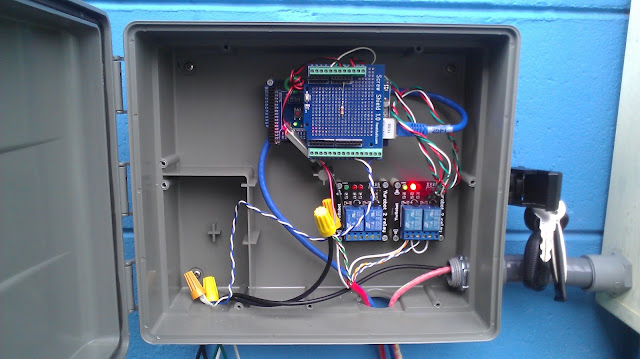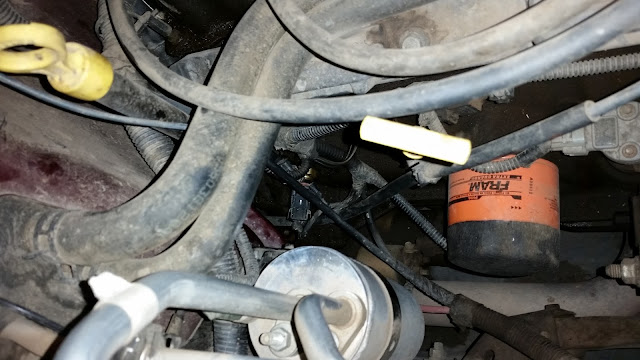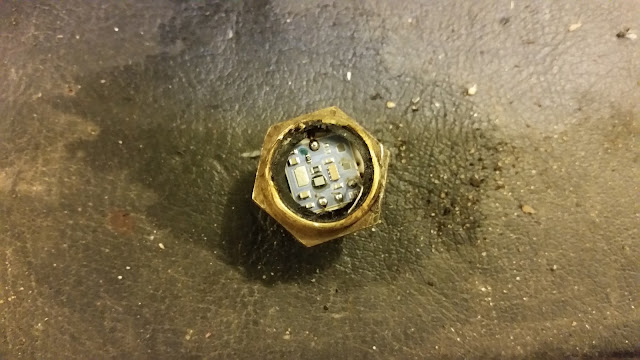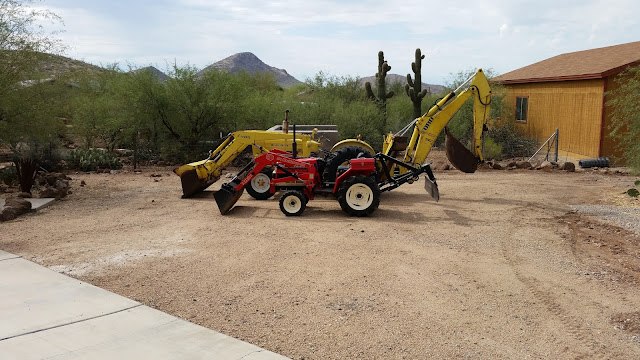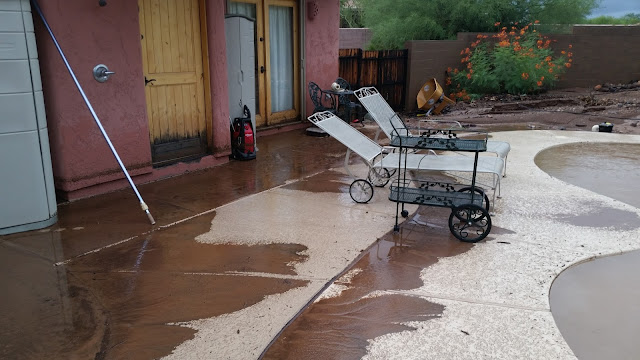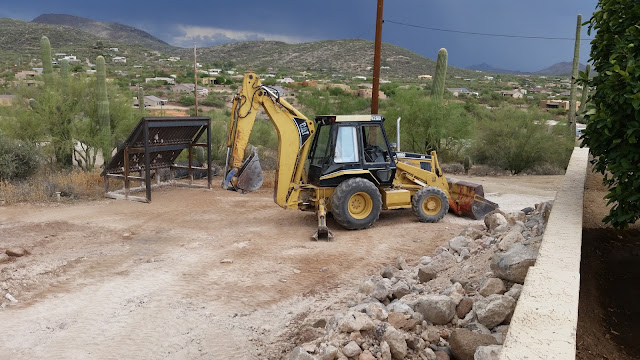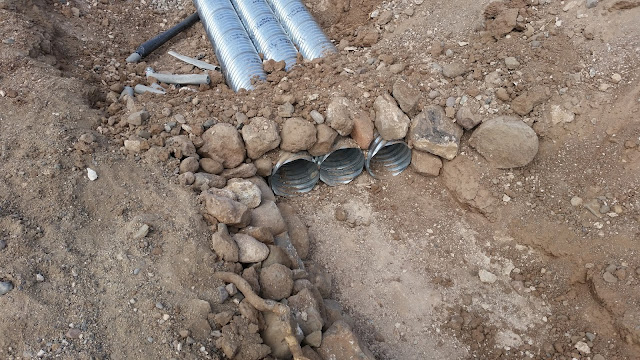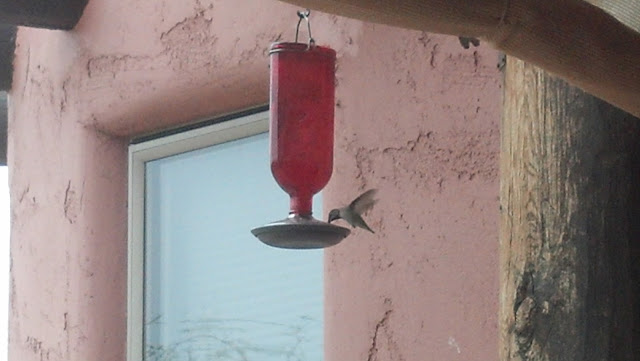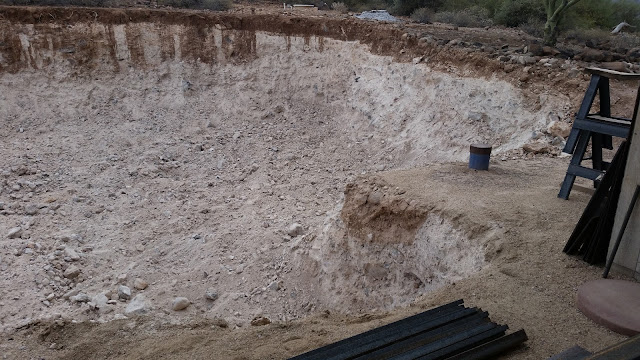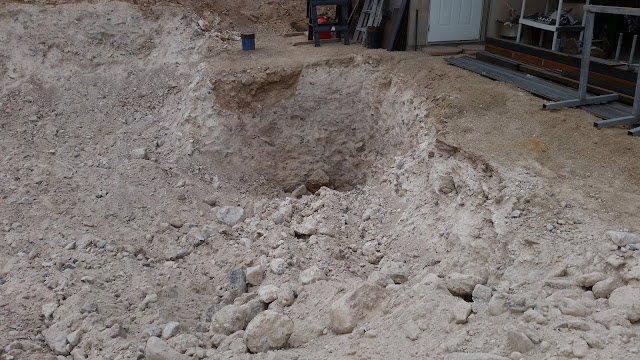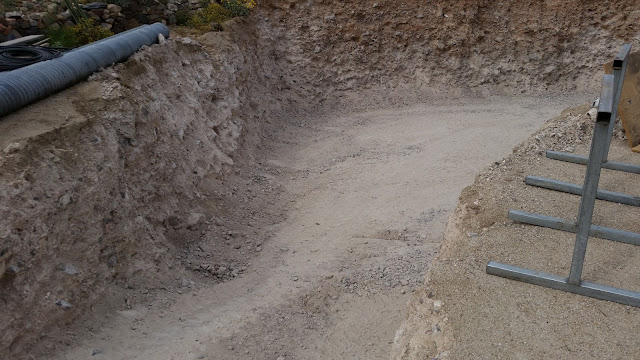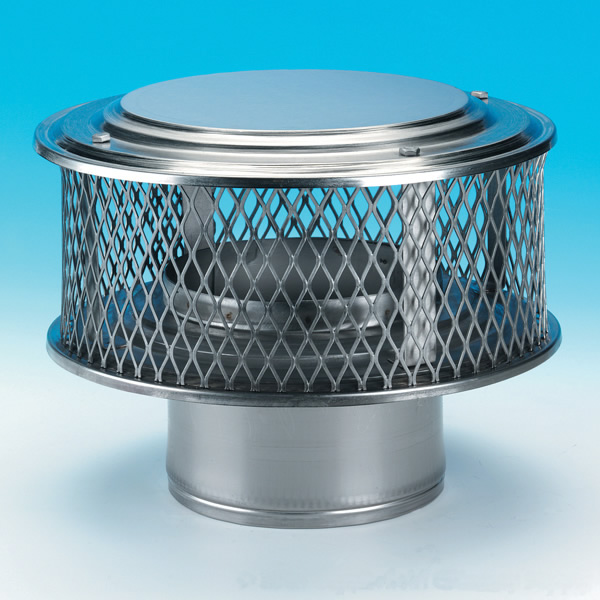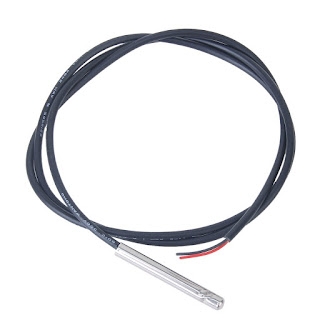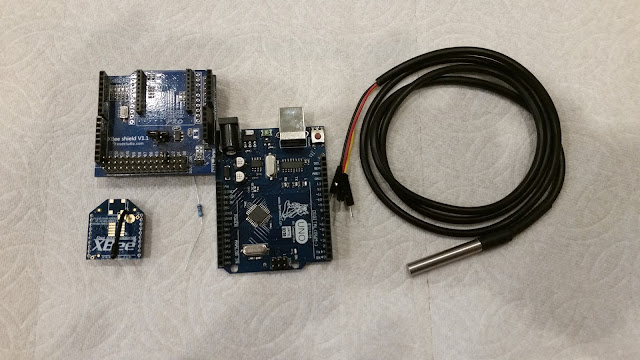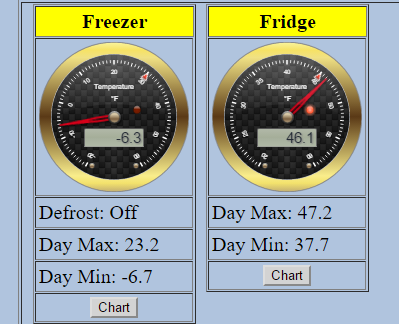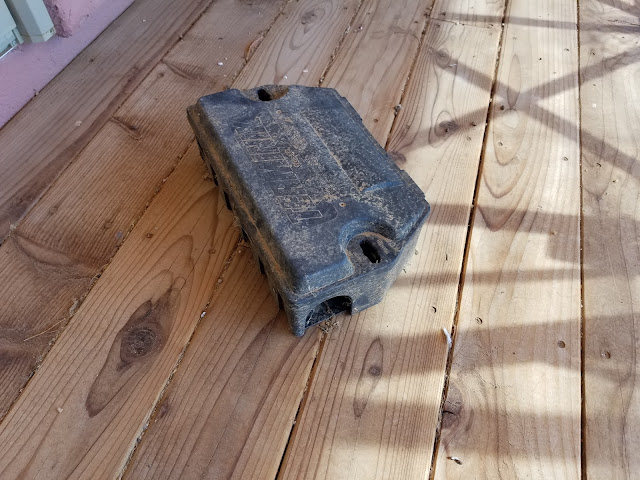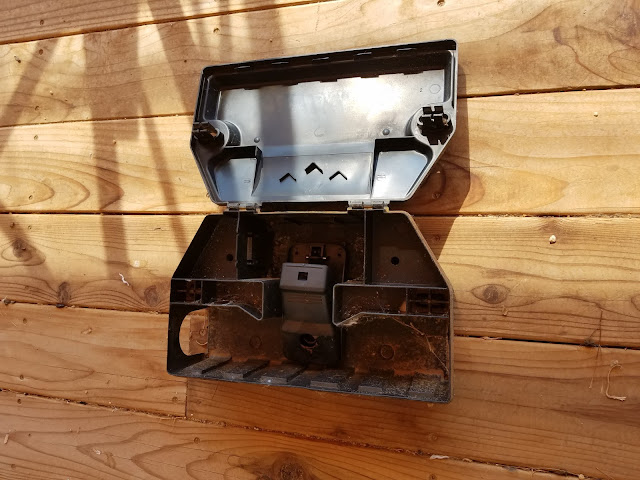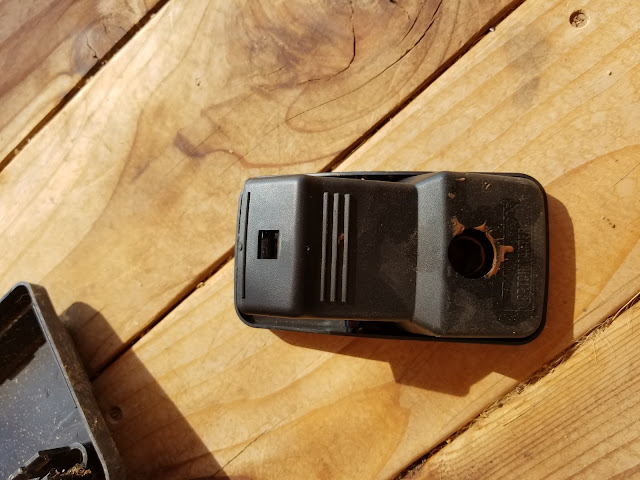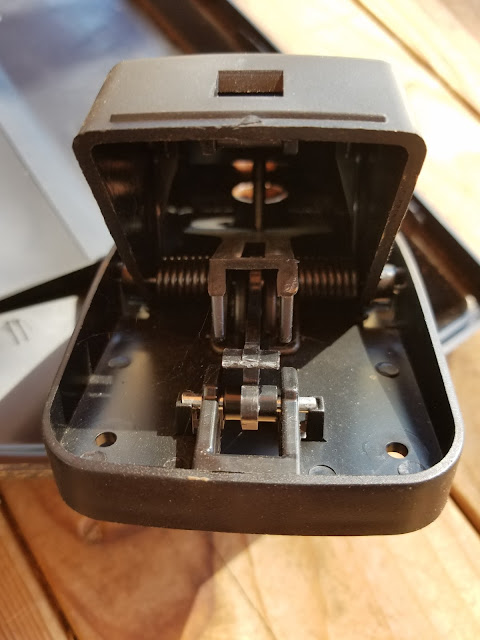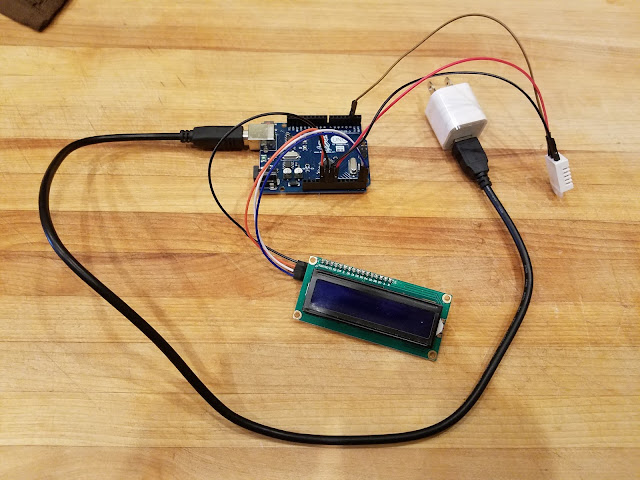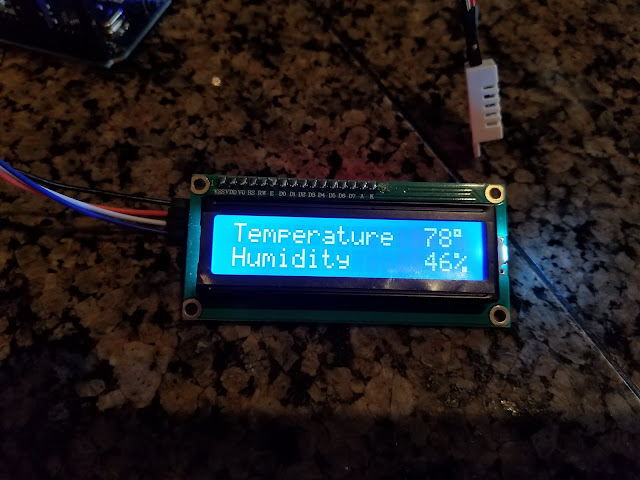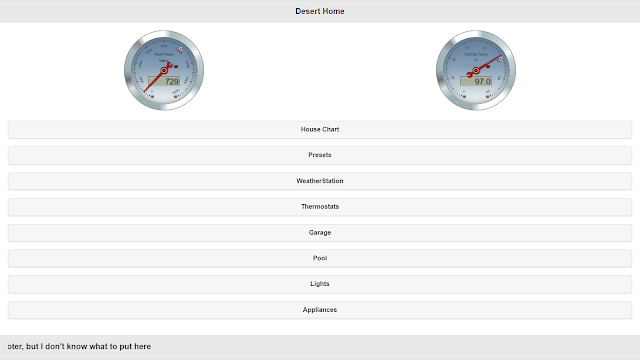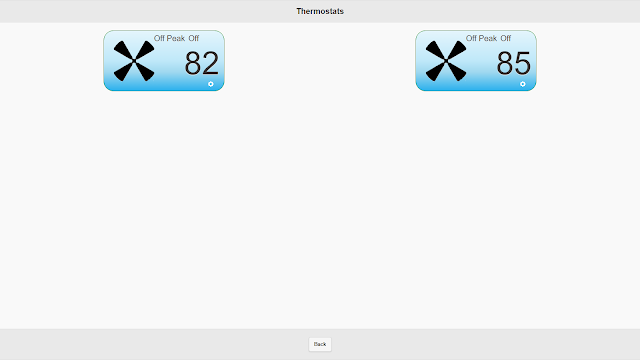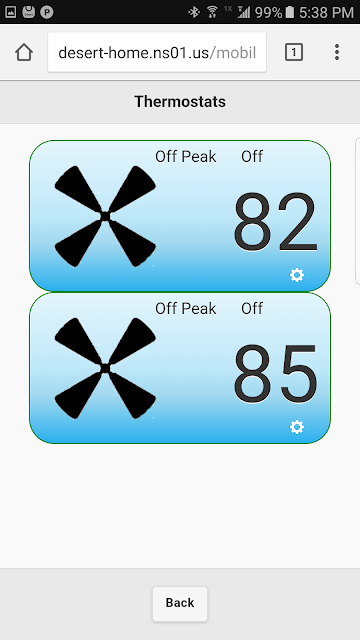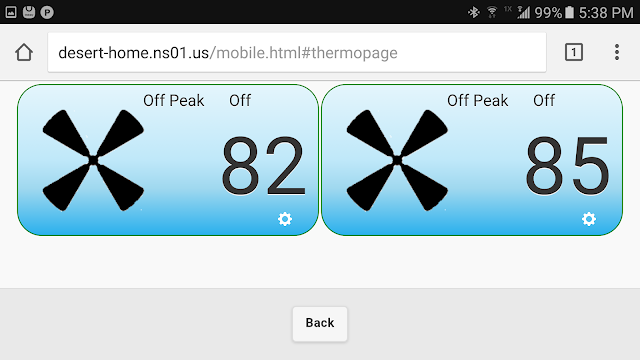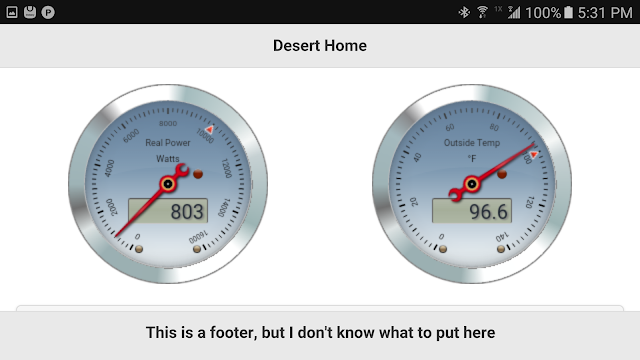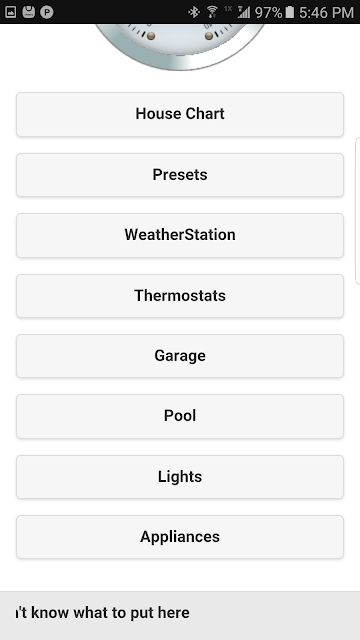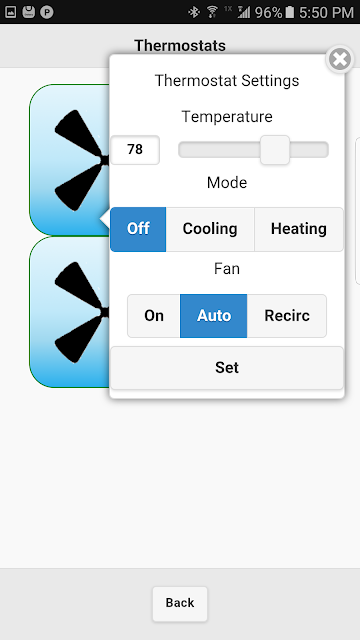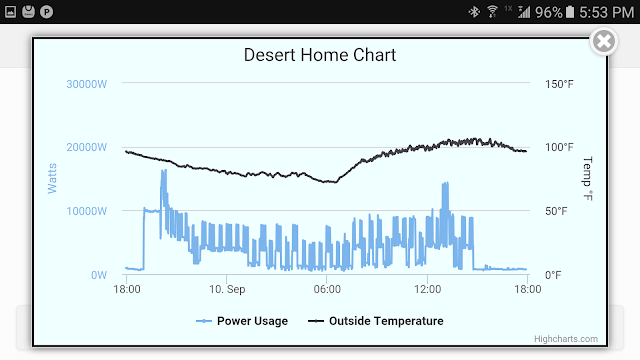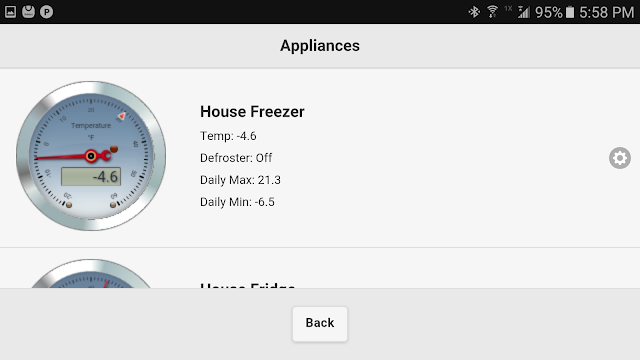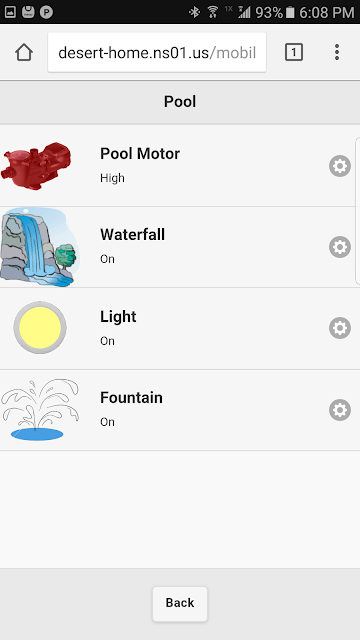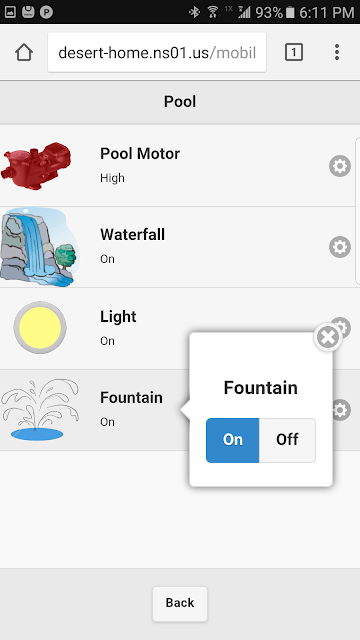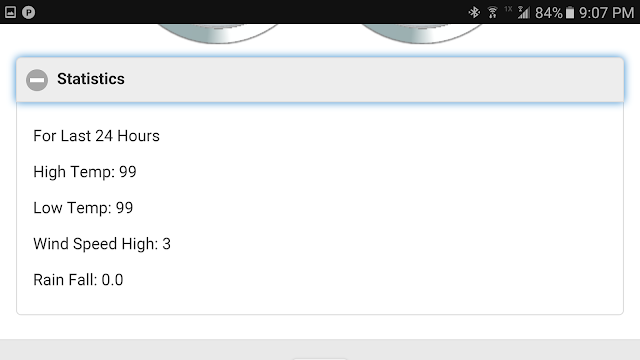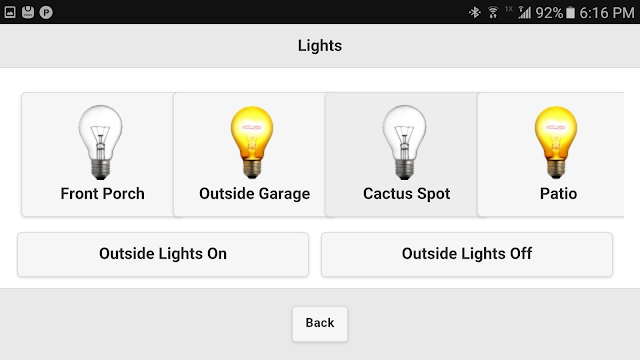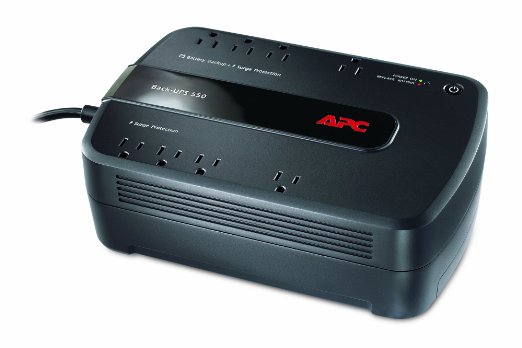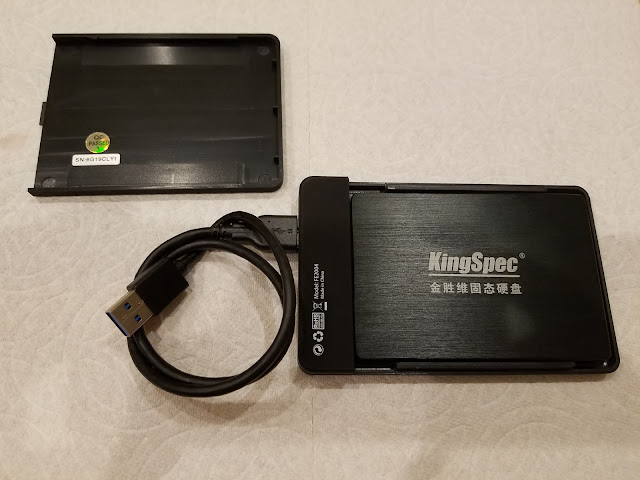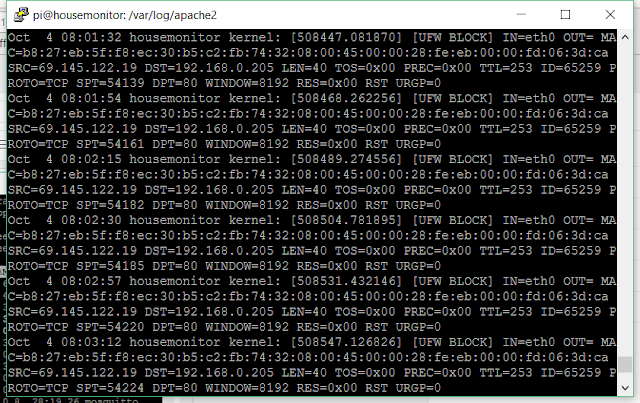The previous post on this project is here <link>.
Well, my partner in questionable activity in hacking the Iris Contact Switch and Key Fob has gotten his devices to work as well as mine, so it's time to close this project off for a while.
The reason my setup worked well and his didn't was because he didn't have a router on his network of Iris devices and I did. The Iris Smart Switch is a router and I have a handful of them scattered around the house. When he plugged one in and tried the devices, his started working and away he went. I just got word that he is switching his network over to completely local control.
Why is a router necessary? Frankly, I'm not sure at this point and I'll check into it more over time, but I have a couple of door switches working quite well, and the key fob controlling one of my smart switches. The system works nicely.
Between the two of us we managed to decode the various timers and such so you folk can pick up where we left off and implement these little devices in your own home for whatever you want. Nicely made (physically) product that was hampered only by the special code Iris put in them to force you to use their hub. I don't know why manufacturers insist on doing that, especially since there are folk like me that will take it as a challenge.
Here's the latest code with the various items. It will support the Iris smart switch, Key Fob and Door Switch. The code doesn't save status to a data base, or forward it to anything else, it just joins the devices and watches them; you'll need to adapt it to what you want to do.
The piece that is still missing is support for an accelerometer that is inside the key fob. I don't have a clue how to initialize and use it. I don't need it, it would just be nice to understand. Maybe after I get some of the other things I'm working on done I'll come back and take another look.
Have fun.
Well, my partner in questionable activity in hacking the Iris Contact Switch and Key Fob has gotten his devices to work as well as mine, so it's time to close this project off for a while.
The reason my setup worked well and his didn't was because he didn't have a router on his network of Iris devices and I did. The Iris Smart Switch is a router and I have a handful of them scattered around the house. When he plugged one in and tried the devices, his started working and away he went. I just got word that he is switching his network over to completely local control.
Why is a router necessary? Frankly, I'm not sure at this point and I'll check into it more over time, but I have a couple of door switches working quite well, and the key fob controlling one of my smart switches. The system works nicely.
Between the two of us we managed to decode the various timers and such so you folk can pick up where we left off and implement these little devices in your own home for whatever you want. Nicely made (physically) product that was hampered only by the special code Iris put in them to force you to use their hub. I don't know why manufacturers insist on doing that, especially since there are folk like me that will take it as a challenge.
Here's the latest code with the various items. It will support the Iris smart switch, Key Fob and Door Switch. The code doesn't save status to a data base, or forward it to anything else, it just joins the devices and watches them; you'll need to adapt it to what you want to do.
#! /usr/bin/pythonRemember, for this to work properly, you'll need one of the Smart Switches in the network, but the Smart Switch that can measure power usage as well as control it was what got me into looking at these devices in the first place. Remember to look at the previous posts on this project as well, I may have forgotten to mention something.
'''
Hacking into the iris door sensor
Have fun
'''
from xbee import ZigBee
import datetime
import time
import serial
import sys, traceback
import shlex
import Queue
from struct import *
import binascii
import inspect
# line number for debugging
def getLineNumber():
return inspect.stack()[1][2]
# show data formatted so I can read it
def showData(data):
print "********** Message Contents"
for key, value in data.iteritems():
if key == "id":
print key, value
else:
print key, "".join("%02x " % ord(b) for b in data[key])
print "**********"
def showClusterData(lAddr,sAddr, clusterId, data):
print int(time.time()),
print "".join("%02x" % ord(b) for b in lAddr) + \
"" + \
"".join("%02x" % ord(b) for b in sAddr) + \
" clid "+"%04x" % clusterId + "-" + \
"".join("%02x " % ord(b) for b in data)
# this is a call back function for XBee receive.
# When a message comes in this function will
# get the data.
# I had to use a queue to make sure there was enough time to
# decode the incoming messages. Otherwise, in heavy traffic
# periods, I'd get a new message while I was still working on
# the last one.
def messageReceived(data):
#print "queueing message"
messageQueue.put(data)
def handleMessage(data):
try:
# if data['source_addr_long'] not in \
# ['\x00\x0d\x6f\x00\x04\x51\x07\x82',]:
# return
#print 'gotta packet'
#showData(data)
if (data['id'] == 'rx_explicit'):
#print "RX Explicit"
#showData(data)
clusterId = (ord(data['cluster'][0])*256) + ord(data['cluster'][1])
#print 'Cluster ID:', hex(clusterId),
if (data['profile']=='\x00\x00'): # The General Profile
print 'Cluster ID:', hex(clusterId),
print "profile id:", repr(data['profile'])
if (clusterId == 0x0000):
print ("Network (16-bit) Address Request")
#showData(data)
elif (clusterId == 0x0004):
# Simple Descriptor Request,
print("Simple Descriptor Request")
#showData(data)
elif (clusterId == 0x0005):
# Active Endpoint Request,
print("Active Endpoint Request")
#showData(data)
elif (clusterId == 0x0006):
print "Match Descriptor Request"
'''
the switch looks for clusters under profile
c216, and I respond with only 1 cluster 02
'''
showData(data)
time.sleep(2)
print "Sending match descriptor response"
zb.send('tx_explicit',
dest_addr_long = data['source_addr_long'],
dest_addr = data['source_addr'],
src_endpoint = '\x00',
dest_endpoint = '\x00',
cluster = '\x80\x06',
profile = '\x00\x00',
options = '\x01',
data = data['rf_data'][0:1] + '\x00\x00\x00\x01\x02'
)
# The contact switch is a bit slow, give it
# some time to digest the messages.
time.sleep(2)
zb.send('tx_explicit',
dest_addr_long = data['source_addr_long'],
dest_addr = data['source_addr'],
src_endpoint = '\x02',
dest_endpoint = '\x02',
cluster = '\x00\xf6',
profile = '\xc2\x16',
data = '\x11\x01\xfc'
)
time.sleep(2)
elif (clusterId == 0x0008):
# I couldn't find a definition for this
print("This was probably sent to the wrong profile")
elif (clusterId == 0x13):
# This is the device announce message.
print 'Device Announce Message'
# this will tell me the address of the new thing
# so I'm going to send an active endpoint request
print 'Sending active endpoint request'
epc = '\xaa'+data['source_addr'][1]+data['source_addr'][0]
print "".join("%02x " % ord(b) for b in epc)
zb.send('tx_explicit',
dest_addr_long = data['source_addr_long'],
dest_addr = data['source_addr'],
src_endpoint = '\x00',
dest_endpoint = '\x00',
cluster = '\x00\x05',
profile = '\x00\x00',
options = '\x01',
data = epc
)
elif (clusterId == 0x8000):
print("Network (16-bit) Address Response")
#showData(data)
elif (clusterId == 0x8005):
# this is the Active Endpoint Response This message tells you
# what the device can do, but it isn't constructed correctly to match
# what the switch can do according to the spec. This is another
# message that gets it's response after I receive the Match Descriptor
print 'Active Endpoint Response'
# elif (clusterId == 0x0006):
elif (clusterId == 0x8038):
print("Management Network Update Request");
else:
print ("Unimplemented Cluster ID", hex(clusterId))
elif (data['profile']=='\xc2\x16'): # Alertme Specific
if (clusterId == 0xee):
clusterCmd = ord(data['rf_data'][2])
status = ''
if (clusterCmd == 0x80):
if (ord(data['rf_data'][3]) & 0x01):
status = "ON"
else:
status = "OFF"
elif (clusterId == 0xef):
clusterCmd = ord(data['rf_data'][2])
status = data['rf_data'] # cut down on typing
if (clusterCmd == 0x81):
usage = unpack('<H', status[3:5])[0]
elif (clusterCmd == 0x82):
usage = unpack('<L', status[3:7])[0] / 3600
upTime = unpack('<L', status[7:11])[0]
#print ("%s Minute Stats: Usage, %d Watt Hours; Uptime, %d Seconds" %(name, usage/3600, upTime))
elif (clusterId == 0xf0):
showClusterData(data['source_addr_long'],data['source_addr'],clusterId,data['rf_data'])
# If the cluster cmd byte is 'xfb', it's a status
if data['rf_data'][2] == '\xfb':
status = data['rf_data'] # just to make typing easier
if status[3] == '\x1f':
print " Door Sensor",
print str(float(unpack("<h", status[8:10])[0])\
/ 100.0 * 1.8 + 32) + "F",
if ord(status[-1]) & 0x01 == 1:
print "reed switch open",
else:
print "reed switch closed",
if ord(status[-1]) & 0x02 == 0:
print "tamper switch open",
else:
print "tamper switch closed",
elif status[3] == '\x1c':
# Never found anything useful in this
print "Power Switch",
elif status[3] == '\x1d':
print " Key Fob",
print str(float(unpack("<h", status[8:10])[0])\
/ 100.0 * 1.8 + 32) + "F",
unpack('<I',status[4:8])[0]
print 'Counter', unpack('<I',status[4:8])[0],
elif status[3] == '\x1e':
# This indicates a door sensor
# with an invalid temperature reading
# the other items are OK
print " Door Sensor",
print "Temperature invalid",
if ord(status[-1]) & 0x01 == 1:
print "reed switch open",
else:
print "reed switch closed",
if ord(status[-1]) & 0x02 == 0:
print "tamper switch open",
else:
print "tamper switch closed",
#This may be the missing link to this thing
print 'sending missing link',
zb.send('tx_explicit',
dest_addr_long = data['source_addr_long'],
dest_addr = data['source_addr'],
src_endpoint = data['dest_endpoint'],
dest_endpoint = data['source_endpoint'],
cluster = '\x00\xf0',
profile = '\xc2\x16',
data = '\x11\x39\xfd'
)
pass
else:
print " Don't know this device yet",
print ''
else:
print " Unknow cluster command"
print ''
pass
elif (clusterId == 0x00f2):
showClusterData(data['source_addr_long'],data['source_addr'],clusterId,data['rf_data'])
print 'Tamper Switch Changed State to',
status = data['rf_data']
if ord(status[3]) == 0x02:
print "Open",
else:
print "Closed",
print ''
pass
elif (clusterId == 0x00f3):
showClusterData(data['source_addr_long'],data['source_addr'],clusterId,data['rf_data'])
print ' Key Fob Button',
status = data['rf_data']
print ord(status[3]),
if status[2] == '\x01':
print 'Closed',
elif status[2] == '\x00':
print 'Open',
else:
print 'Unknown',
print 'Counter', unpack('<H',status[5:7])[0],
print ''
pass
elif (clusterId == 0xf6):
showClusterData(data['source_addr_long'],data['source_addr'],clusterId,data['rf_data'])
print ''
print "Identify Message"
#extract vendor strings
v = data['rf_data']
vendorstr = " - Vendor:"
start = 21
datalen=len(v)
while(start < datalen):
slen=ord(v[start])
vendorstr = vendorstr + "" + v[start+1:start+1+slen]
start = start+slen+1
print vendorstr
print "Sending init message"
zb.send('tx_explicit',
dest_addr_long = data['source_addr_long'],
dest_addr = data['source_addr'],
src_endpoint = '\x00',
dest_endpoint = '\x02',
cluster = '\x00\xf0',
profile = '\xc2\x16',
data = '\x19\x41\xfa\x00\x01'
)
elif (clusterId == 0x0500): # This is the security cluster
showClusterData(data['source_addr_long'],data['source_addr'],clusterId,data['rf_data'])
showData(data)
# When the switch first connects, it come up in a state that needs
# initialization, this command seems to take care of that.
# So, look at the value of the data and send the command.
if data['rf_data'][3:7] == '\x15\x00\x39\x10':
print "sending initialization"
zb.send('tx_explicit',
dest_addr_long = data['source_addr_long'],
dest_addr = data['source_addr'],
src_endpoint = data['dest_endpoint'],
dest_endpoint = data['source_endpoint'],
cluster = '\x05\x00',
profile = '\xc2\x16',
data = '\x11\x80\x00\x00\x05'
)
# The switch state is in byte [3] and is a bitfield
# bit 0 is the magnetic reed switch state
# bit 3 is the tamper switch state
switchState = ord(data['rf_data'][3])
if switchState & 0x04:
print 'Tamper Switch Closed',
else:
print 'Tamper Switch Open',
if switchState & 0x01:
print 'Reed Switch Opened',
else:
print 'Reed Switch Closed',
print ''
pass
else:
print ("Unimplemented Cluster ID", hex(clusterId))
else:
print ("Unimplemented Profile ID")
elif(data['id'] == 'route_record_indicator'):
print("Route Record Indicator")
else:
print("some other type of packet")
print(data)
except:
print "I didn't expect this error:", sys.exc_info()[0]
traceback.print_exc()
def stopXBee():
print("XBee stop handler")
zb.halt()
ser.close()
####################### Actually Starts Here ################################
#------------ XBee Stuff -------------------------
# this is the /dev/serial/by-id device for the USB card that holds the XBee
ZIGBEEPORT = "/dev/serial/by-id/usb-FTDI_FT232R_USB_UART_A901QL3F-if00-port0"
ZIGBEEBAUD_RATE = 57600
# Open serial port for use by the XBee
ser = serial.Serial(ZIGBEEPORT, ZIGBEEBAUD_RATE)
# The XBee addresses I'm dealing with
BROADCAST = '\x00\x00\x00\x00\x00\x00\xff\xff'
UNKNOWN = '\xff\xfe' # This is the 'I don't know' 16 bit address
# create a queue to put the messages into so they can
# be handled in turn without one interrupting the next.
messageQueue = Queue.Queue(0)
# Create XBee library API object, which spawns a new thread
zb = ZigBee(ser, callback=messageReceived)
print "started"
while True:
try:
if messageQueue.qsize() > 0:
#print "getting message"
message = messageQueue.get()
handleMessage(message)
messageQueue.task_done();
sys.stdout.flush() # if you're running non interactive, do this
except KeyboardInterrupt:
print "Keyboard interrupt"
zb.halt()
ser.close()
break
except:
print "Unexpected error:", sys.exc_info()[0]
traceback.print_exc()
break
print ("After the while")
# just in case
zb.halt()
ser.close()
The piece that is still missing is support for an accelerometer that is inside the key fob. I don't have a clue how to initialize and use it. I don't need it, it would just be nice to understand. Maybe after I get some of the other things I'm working on done I'll come back and take another look.
Have fun.


